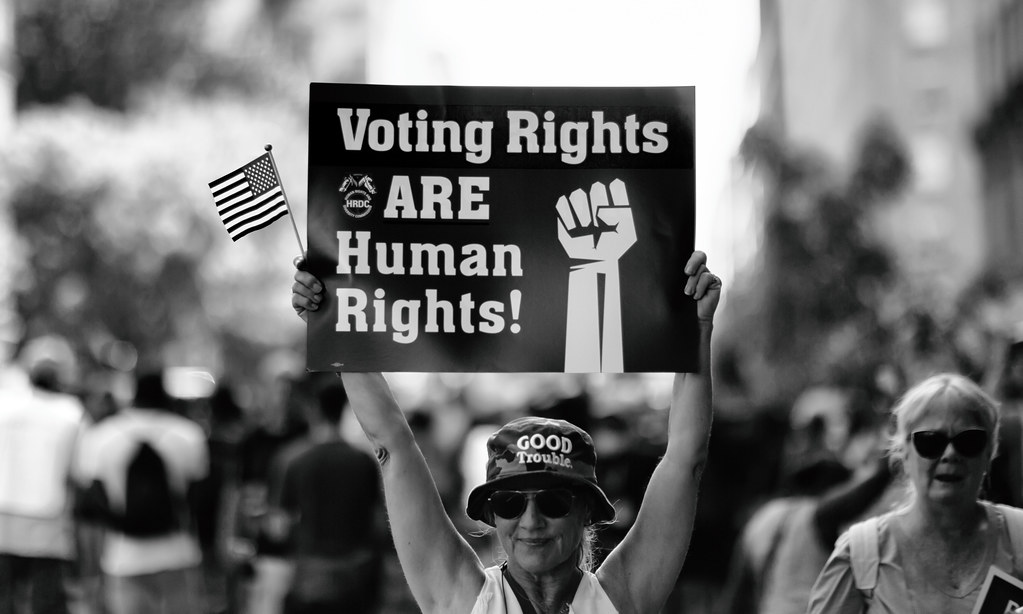The Foundation of Modern Voting Rights

The Voting Rights Act of 1965 stands as one of the most transformative pieces of legislation in American history. By the end of 1965, a quarter of a million new Black voters had been registered, one-third by federal examiners. This landmark law emerged from the violent confrontation on the Edmund Pettus Bridge during “Bloody Sunday” in 1965, when peaceful protesters were brutally attacked by state police. The outrage over this incident prompted immediate national action in Congress, spurred by President Lyndon Johnson. The law was a more fulsome response than prior, inadequate efforts to assure that states registered citizens and allowed them to vote regardless of race.
It outlawed the discriminatory voting practices adopted in many southern states after the Civil War, including literacy tests as a prerequisite to voting. The Act didn’t just prohibit discrimination—it fundamentally transformed how America approached voting rights protection.
The Immediate Impact That Changed Everything

The results were nothing short of revolutionary. By the end of 1966, only four out of 13 southern states had fewer than 50 percent of African Americans registered to vote. This represented a seismic shift in American democracy, breaking down barriers that had persisted for nearly a century. The disparity in voter registration rates between white and Black Americans fell from nearly 30 percentage points in the early 1960s to just eight points by the 1970s.
Research shows that the Act had successfully and massively increased voter turnout and voter registrations, in particular among black people. But the impact extended far beyond the voting booth. Between 1950 and 1980, the gap between median wages of Black and white workers in the South narrowed by approximately 30 percentage points. The Voting Rights Act was responsible for about one-fifth of that reduction.
The Heart of the Act: Preclearance Protection

The most innovative feature of the Voting Rights Act was Section 5’s preclearance requirement. For almost 50 years, the Voting Rights Act was arguably the most effective piece of civil rights legislation in the nation’s history, and the preclearance requirement, found in Section 5 of the law, was its most innovative and impactful provision. This system required certain jurisdictions with histories of discrimination to get federal approval before changing their voting laws.
For nearly 50 years, Section 5 of the Voting Rights Act (VRA) required certain jurisdictions (including states, counties, cities, and towns) with a history of chronic racial discrimination in voting to submit all proposed voting changes to the U.S. Department of Justice (U.S. DOJ) or a federal court in Washington, D.C. Preclearance was a huge success, preventing discriminatory voter suppression laws from taking effect.
The Shelby County Earthquake of 2013

Everything changed on June 25, 2013, when the Supreme Court dealt a devastating blow to voting rights. The U.S. Supreme Court issued a devastating decision, Shelby County v. Holder, which dealt a significant blow to the Voting Rights Act of 1965. The Court struck down the law’s formula for determining which states and localities should be required to get federal approval for changes to voting policies to ensure that they were not racially discriminatory.
The effects of the ruling were immediate. The same day, Texas officials announced that they would implement the nation’s most restrictive voter ID law, which had previously been blocked in the preclearance process. Justice Ruth Bader Ginsburg wrote in her dissent, “Throwing out preclearance when it has worked and is continuing to work to stop discriminatory changes is like throwing away your umbrella in a rainstorm because you are not getting wet.”
The Avalanche of Restrictive Laws

The Shelby County decision opened the floodgates for voter suppression. According to the Brennan Center for Justice, at least 31 states have passed 103 restrictive voting laws since the Shelby decision. At least 31 states have passed 115 restrictive voting laws since Shelby County, including at least 44 laws in states that were previously subject to preclearance.
In 2021, at least 17 states enacted 32 restrictive laws, while at least 8 states passed 11 new restrictions in 2022, at least 14 states passed 17 restrictive laws in 2023, and at least 10 states passed 19 restrictive laws in 2024. These aren’t just abstract policy changes—they’re direct attacks on voting access, particularly for communities of color.
Modern Discrimination Takes New Forms

Today’s voting discrimination looks different from the literacy tests and poll taxes of the past. While the Court may have found that the coverage formula was no longer responsive to modern circumstances, that the country had changed, so too have the methods of voter suppression. The mechanisms are no longer grandfather clauses and literacy tests.
Stricter voter ID laws (such as those passed in North Carolina and Texas immediately following the Shelby County decision) have made it harder for minorities, elderly and low-income people, students, and other groups to vote. These laws don’t affect everyone equally, as suppressive voting laws consistently target the ways people of color vote.
The Racial Gerrymandering Crisis

Redistricting has become a powerful tool for vote dilution. Racially discriminatory redistricting has expanded. Mapmakers across the country are minimizing minority voting power. Courts in at least six previously covered states found Congressional maps to be discriminatory since 2021. They will be redrawn for 2024, but the 2022 elections were held under those unfair maps.
Stunningly, in recent years Alabama and Louisiana —who were previously subject to preclearance — have defied a Supreme Court order to fix racial gerrymanders. This represents a level of defiance that would have been unthinkable under the full protection of the Voting Rights Act.
The High Cost of After-the-Fact Litigation

Without preclearance, civil rights groups must fight discrimination through expensive, time-consuming lawsuits. What’s left of the Voting Rights Act is not enough to fight voting discrimination. After-the-fact lawsuits alone are not enough where discrimination is pervasive. They take years to resolve before voters see results and often cost millions of dollars.
Though non-profit organizations like the ACLU can challenge such practices in court, this process can take several years and elections before a decision is reached. During this time, elections are held with policies that can later be found to be discriminatory. Yet, our system is not really designed to unravel elections once they have been decided.
The Battle for Section 2

Even Section 2 of the Voting Rights Act, which allows lawsuits against discriminatory practices, has been weakened. In 2021, the Brnovich v. Democratic National Committee Supreme Court ruling reinterpreted Section 2 of the Voting Rights Act of 1965, substantially weakening it. The ruling interpreted the “totality of circumstances” language of Section 2 to mean that it does not generally prohibit voting rules that have disparate impact on the groups that it sought to protect.
In particular, the ruling held that fears of election fraud could justify such rules without evidence that any such fraud had occurred in the past or that the new rule would make elections safer. This creates a dangerous precedent where imaginary fears can justify real discrimination.
The John Lewis Voting Rights Advancement Act

There is hope on the horizon. On March 5, 2025, lawmakers in the House reintroduced the John R. Lewis Voting Rights Advancement Act. The bill would undo the damage done by the Supreme Court and create a Voting Rights Act for the 21st century. It would restore preclearance in states that are discriminating on the basis of race and create preclearance for certain practices that are frequently discriminatory.
The bill would modernize and revitalize the Voting Rights Act of 1965, strengthening legal protections against discriminatory voting policies and practices. A state and all of its political subdivisions shall be subject to preclearance of voting practice changes for a 10-year period if, during the previous 25 years: 15 or more voting rights violations occurred in the state; 10 or more violations occurred, at least 1 of which was committed by the state itself; or 3 or more violations occurred and the state administers the elections.
Current Political Realities

The path forward faces significant political obstacles. Senate Republican Leader Mitch McConnell has expressed opposition to passage of the bill, and said that its passage is “unnecessary” because there is currently “no threat to the voting rights law”. Republicans have argued that the act is an attempt to federalize control of state elections to the Democrats’ advantage.
The bill later failed in the Senate after it was unable to receive enough votes to invoke cloture. This political deadlock means that voting rights protections remain weakened while discriminatory practices continue to spread.
The Ongoing Threat to Democracy

The stakes couldn’t be higher for American democracy. According to a Brennan Center for Justice study, in 2024, at least 10 states enacted restrictive voting laws, and lawmakers in at least 40 states considered more than 300 bills aimed at making it harder to vote. Since the Supreme Court gutted the Voting Rights Act, dozens of states have enacted laws making it harder to vote, especially for people of color. The result: a growing racial turnout gap.
As we mark the 59th anniversary of the Voting Rights Act this week, Black voters and other voters of color face a renewed effort to erode critical civil rights protections and to increase barriers at the ballot box. Project 2025, the Heritage Foundation’s extreme agenda for a second Trump administration, could take America back to the Jim Crow era.
The Path Forward

The Voting Rights Act of 1965 transformed American democracy by ensuring that all citizens could participate in the political process. Today, that progress is under attack through sophisticated new forms of discrimination. The Supreme Court justified its decision to significantly weaken the Voting Rights Act by suggesting that race discrimination in voting was a thing of the past. That was clearly wrong at the time and it has only gotten worse since.
The fight for voting rights isn’t just about protecting the past—it’s about securing the future of American democracy. But Congress has the power to guarantee all Americans’ access to the ballot. Congress has a chance to protect the freedom to vote against a wave of discriminatory state laws. The question remains whether America will choose to strengthen its democracy or allow it to be weakened by those who would turn back the clock on progress.







